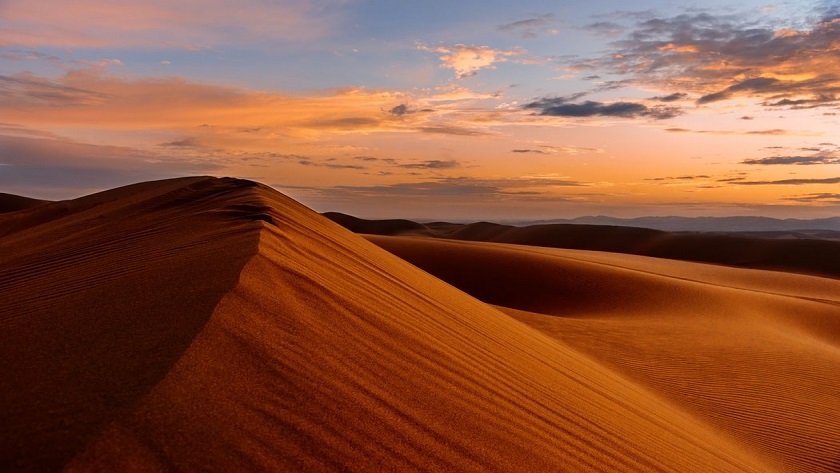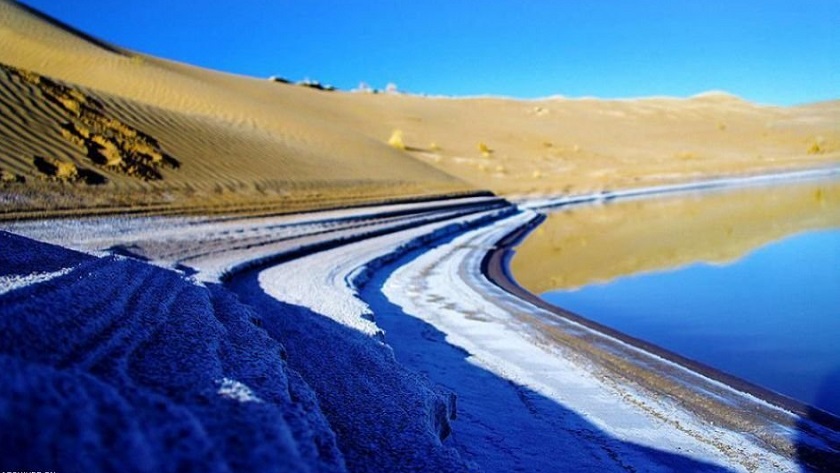Iran Press/ Iran News: Deserts are among the world’s most dramatically seductive natural habitats. In Iran’s deserts, spotted diverse animal life can be spotted, including insects and wild animals with a rich variety of spectacular desert landforms.
 Golden sands shining in desert
Golden sands shining in desert
The desert, Sahara, Kavir or Kalout are scientifically different, and their differentiations depend on altitude, annual precipitation, the type of vegetation, amount of salt present in the soil and natural formations. In Iran, there are all types of deserts whose sand dunes, salt rivers, salt lakes, desert plants, birds and wildlife, attract thousands of tourists depending on the regional and climatic conditions.
Related news: Wonders of nature in Iran's Bafgh desert
Geographical features of Iran's deserts
Iranian deserts are one of the most beautiful and varied deserts in the world. There are 2 large and separate desert systems and in many ways quite different from each other.
 Two important deserts are shown in the map
Two important deserts are shown in the map
Dasht-e Kavir desert also known as the central desert (Kavir-e Markazi) is in north- central part of Iran with 800 km in length and 500 km in width, a total surface area of about 77,600 km².
Dasht-e Lut desert (Kavir-e Lut) is the other desert system located in the southeast of the country with 480 km length and 320 km width registered on the list of UNESCO heritage sites in 2016.
 Desert touches sky at dusk
Desert touches sky at dusk
One can still find people who live a relatively traditional life with extremely modest facilities, making their living mostly off the land. Some even have no electricity, but they like it and is a personal choice. This is becoming an increasingly rare phenomenon in the world.
 Carcal wild cat roams Iranian deserts
Carcal wild cat roams Iranian deserts
Among the significant plant species of this region Alhagi, Acantholimon, Atraphaxis, Haloxylon, Tamarisk are mentionable. Various animal species such as gazelles, Pseudocerastes, Cheetahs, Rueppell’s foxes, Caracals, Sand cats, Persian Onager and Golden Eagles can be seen in this desert area.; However; the major part of Dasht-e Kavir is devoid of plant life and the ground is low, causing dreadful swamps after small amounts of rainfall. As a result, crossing the desert without prior research and thorough study of the wet season isn’t recommended.
Related news: Persian Caravanserai; What Iran is known for
 Tourists enjoying camel riding at desert
Tourists enjoying camel riding at desert
Dasht e Kavir or the Central desert
Dasht-e Kavir, 300km long and 400 km wide, is the largest desert located on the Iranian plateau. Some of the most important parts of this desert include; dangerous swaps found in the southern and central parts, the areas covered by sand dunes, areas covered by clay and Himalayan black salt and the areas devoid of plant life.
 Amazing beauty of Dasht e Karvir desert
Amazing beauty of Dasht e Karvir desert
Related article: Windcatcher; What Iran is known for
In addition, craters resembling volcanic crates can be seen in the central parts of the desert, created as a result of rapid evaporation and low density of the soil. The lowest spot of Dasht-e Kavir is the northern part with 650 m of altitude above sea level and the highest spot, 838 m, is located north of Namak Lake and Biaybanak village.
 Glittering stars in night sky of the Iranian desert are astonishing
Glittering stars in night sky of the Iranian desert are astonishing
Related news: Naqsh-e Jahan Square; What Iran is known for
Dasht-e Lut (The Lut Desert):
is the second largest desert of Iran with an area of 95800 sq km, and is located between the provinces of Khorasan, Kerman, and Yazd and is considered one of the driest and warmest deserts of the world. The length of this desert, from northwest to southeast, is about 700 km, and its width varies between 50 to 150 km. The Lut Desert can be divided into Northern Lut and Southern Lut.
 Lut desert has among the hottest spots on earth
Lut desert has among the hottest spots on earth
The Northern Lut starts near Tabas and connects to the Dasht-e Kavir through a strait in the south of Rabat Khan. The Southern Lut, on the other hand, ends at the foothills of Sistan and Baluchestan in the east and the mountain range of Jabal Bazar, Plovar, and Jopar in Kerman Province.
 Mesr desert is among top tourist attractions
Mesr desert is among top tourist attractions
Mesr Desert
The Mesr Desert named because of a simple and lovely village with the same name. This area is located in Isfahan Province, 55 km from Khoor city and near the village of Garmeh. In addition to the sandy hills and Ramps, which are the main attractions of the desert. Other attractions of nature and tourism can be mentioned, such as Abbasid throne, palms and canebrake of the Mesr Village.
 Colorful sky at Maranjab desert
Colorful sky at Maranjab desert
Marnjab Desert
Maranjab desert is one of the most popular desert attractions in Iran and Isfahan province. It is just a short distance from Tehran and is located near Aran and Bidgol. The attractions of nature and tourism include sandy hills and Ramps, Abbasid caravanserai and the wandering island. Also It has also been one of the astronomy site in Iran.
 caravanserai hosts tourists at Maranjab
caravanserai hosts tourists at Maranjab
Deserts as tourist attractions
The deserts of Iran encompass all that is needed in adventure desert tours in an intact and beautiful nature. These deserts have been interestingly formed of diverse and colorful forms.
From the barren desert to the golden sand dunes, the pleasure of walking along sand dunes meeting local people and experiencing desert tours by visiting Iran is un unforgettable.
Read More:
Iranian Hospitality; What Iran is known for
Star rain night sky in Iran's Northern Khorasan; unique spectacular moments
Ashkan Salehian

